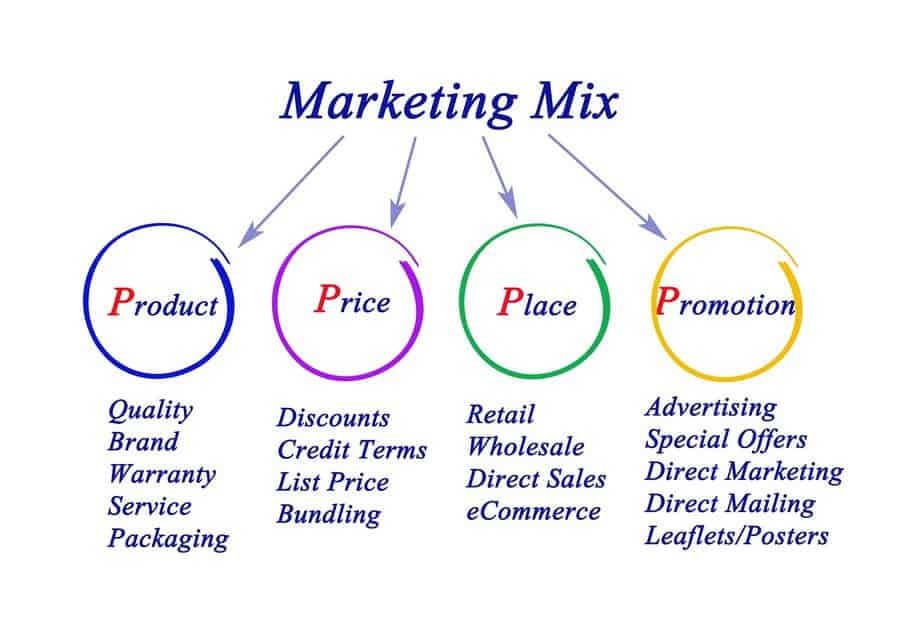When it comes to promoting a product or service, the most important considerations are what is known as the “Four Ps”.
Product, pricing, location, and promotion of a good or service are the four Ps.
The four Ps, also commonly referred to as the marketing mix, are constrained by internal and external elements in the overall business environment, and they interact greatly with each other.
In addition, the four Ps are also referred to as the marketing mix.
Companies will use the 4 Ps to determine some of the most important aspects of their business, such as what their customers want from them, how their product or service meets or fails to meet those needs, what their product or service should be, how it is perceived in world, how they differentiate themselves from their competitors, and how they communicate with their customers.
Understanding The 4 Ps Of Marketing.
In the 1950s, Neil Bourdain became widely known for popularizing the idea of the marketing mix, as well as the concepts that eventually became known as the Four Ps.
At the time of his death, Borden was a professor of advertising at Harvard University.
In his paper published in 1964 and titled “The Concept of the Marketing Mix”, he outlined the various ways in which businesses can engage their customers through the employment of advertising strategies.
Even now, many decades after Bourdain’s contribution, businesses continue to sell their products and services using the same ideas he popularized.
Bourdain’s ideas had a significant impact on the corporate world almost immediately after they were introduced, and other important figures in the field continued to evolve and improve over the years.
It was Michigan State University marketing professor E. Jerome McCarthy who actually developed the ideas that were presented in Bourdain’s book and came up with the concept of the “4 Ps”, a phrase that is still used in business today.
In 1960, McCarthy collaborated with the writing of the book “Basic Marketing: A Managerial Approach”, which helped spread the concept of the “4 Ps”.
When it was first conceived, the marketing mix was intended to help businesses take into account the physical barriers that impede general acceptance of a product.
The use of the Internet has made it possible for businesses to achieve a higher level of integration between themselves and their customers, as well as remove some of the barriers that already exist.
The original “4 Ps” has been expanded to include “people, process and physical evidence”, all of which are more relevant to developments currently taking place in marketing.
How The Four Ps Work In Marketing?

Here is how 4 ps of marketing works:
1. Product.
The product can be related to either a tangible good or an intangible service that a corporation provides to its customers.
In an ideal world, a product would satisfy a need that already exists among consumers.
Or, a product may be so attractive that customers feel they have no choice but to buy it, therefore creating more demand.
Marketers must have an understanding of a product’s life cycle to be successful, and business leaders need a strategy for dealing with products at every point in their life cycle.
Product type has a role to play in determining not only how much a company can ask for, but also where they should put it and how they should promote it in the market.
Many of the items that have been the most successful in their category were the first of their kind.
For example, Apple was the first company to develop a touchscreen smartphone that was also capable of listening to music, surfing the Internet, and making phone calls.
In the first quarter of 2022, Apple claimed total sales of iPhones were $71.6 billion.
The year 2021 marked the year that Apple reached the milestone of selling two billion iPhones.
2. Price.
The price of a product is the amount that customers are required to pay money for it.
Marketers are obliged to link the price of a product to both its actual and perceived value; But, they must also take into account the cost of supply, seasonal cuts, and prices offered by competitors.
Business leaders may choose to boost the price of a product to create the impression that it is a luxury item under certain circumstances.
Alternatively, they may lower the price to encourage more customers to offer the product.
In addition, marketers are responsible for determining whether price cuts are needed.
When compared to when it is priced higher, the discount can give the impression that the product is not as exclusive or as luxurious as it was when it was priced higher.
This may result in the business losing some customers.
UNIQLO is a clothing manufacturer that specializes in worldwide casual wear and is headquartered in Japan.
UNIQLO, like its competitors, which include well-known casual wear retailers like Gap and Zara, designs affordable clothing for day-to-day use.
The fact that UNIQLO manufactures goods that are both original and of good quality is what sets the company apart from its competitors.
It has been able to accomplish this by sourcing its fabrics from its content manufacturing partners, ordering bulk quantities consistently to obtain high-quality and affordable cost materials, and by relentlessly searching for the highest quality and lowest priced materials in the world.
The company also engages in direct dialogue with its manufacturers and has developed strategic alliances with Japanese manufacturers who are known for their excellent quality and creative products.
UNIQLO also contracts the manufacture of its goods to third-party partner factories.
Since the company does not have any manufacturing facilities of its own, it is free to switch production partners whenever the optimum site for manufacturing changes over time.
Lastly, the business has a group of highly qualified textile artisans on staff, which it sends to various partner factories located around the world to conduct quality assurance inspections.
In addition, production managers make weekly visits to factories to resolve any quality issues that may arise.
3. Place.
When a firm is trying to establish where they should sell the product and how they should distribute the product in the market, they will make decisions about the place to serve these two goals.
Promoting a company’s merchandise to the customers most likely to make a purchase is always the primary objective of the executives in charge of running a firm.
It is possible that it is referring to the act of placing a product on the shelves of specific retailers, but more often than not, it is referring to the act of displaying that product at those stores.
When referring to a particular product, the term “placement” may in some cases refer to the act of including that product on television shows, movies, or web pages in order to draw attention to that particular product.
The James Bond film series continued with the seventeenth installment titled GoldenEye, which was released in 1995.
It was the first James Bond film in which the Aston Martin vehicle did not appear.
Instead, British actor Pierce Brosnan entered the BMW Z3 as his vehicle of choice.
BMW took 9,000 pre-orders for the Z3 in the first month after the film’s release, despite the fact that the car didn’t go on sale until several months after it was removed from theaters.
4. Promotion.
Advertising, public relations, and promotional strategy are the three components of makeup promotion.
The purpose of marketing a product is to make consumers believe that they need the product and should be prepared to pay a specific amount for it.
To target their primary consumers, marketers typically combine the concepts of promotion and placement into a single strategy.
For example, in this day and age, the “location” and “promotion” elements play just as important a role online as they do offline.
Specifically, the location of a product on a company’s website or social media platform, as well as the specific types of search features that cause the product to match, display targeted ads.
In the year 1980, only 10,000 cases of Swedish vodka brand Absolute were sold in the United States.
However, by the year 2000, the business had already sold 4.5 million cases, partly due to the memorable advertising campaign.
Graphics used in the campaign depict the company’s trademark bottle as a variety of fictional images, such as a bottle with a halo, a bottle made of stone, or the outline of trees on a ski slope.
Beginning in 1981 and continuing through 2005, this ad campaign for Absolute is one of the longest-running campaigns to hold the record.
Frequently Asked Questions About The Four Ps Of Marketing.
Some questions regarding 4 ps of marketing:
What Do The 4 Ps Mean In Marketing?
The “4 Ps,” which are product, pricing, promotion, and place, make up the marketing mix.
These are the most important considerations that come up during the process of marketing a product or service.
What Are The Examples 4 Ps Of Marketing?
Location, price, product, and promotion are referred to as the “4 Ps” of marketing.
Companies are able to ensure that they have a product or service that is in demand and competitively priced, by carefully combining all of these marketing methods into the marketing mix.
It allows companies to promote the product or service to their customers.
Location refers to the locations and channels through which customers purchase your product.
Consumers purchase goods and services in a variety of settings in person at retail locations, through a web browser, through a smartphone app, at trade shows or events, through marketplace channels such as Amazon or Walmart, or through Assistance of a sales professional.
Some of these settings are listed below.
The term “price” refers to the monetary value of your goods or services.
Your competition, demand for the product, the cost of producing the product, and the amount consumers are willing to spend all play a part in determining how you should price your goods.
Additionally, businesses need to think about their pricing model, including deciding between a one-time purchase and a subscription-based model.
The term “products” refers to the goods or services that your company provides to consumers who make up your ideal demographic.
The products a company offers can change significantly depending on the type of business it is in and the activities it engages in.
For example, McDonald’s offers dependable quick meals such as hamburgers, french fries, and items made from chicken, while Salesforce provides customers.
Relationship Management (CRM) software as well as marketing automation tools for companies.
The term “promotion” refers to advertising that is targeted and tailored so that it reaches the demographic that an organization is trying to attract.
A corporation may choose to engage in a campaign on Instagram, a public relations campaign that highlights a product, or an email campaign to engage with its audience in the ideal location immediately.
How To Use The 4 Ps Of Marketing?
You can use the concept of 4Ps when you’re building a new company venture, analyzing existing offers, or trying to maximize sales with your target demographic. In addition, you can test your current marketing plan with it.
Conclusion.
The marketing mix is a term commonly used to refer to the product, price, place, and promotion that make up the four Ps of marketing.
These are the most important aspects of marketing a product or service and have a large amount of interaction with each other.
One way to develop an overall marketing plan is to take each of these components into account.







